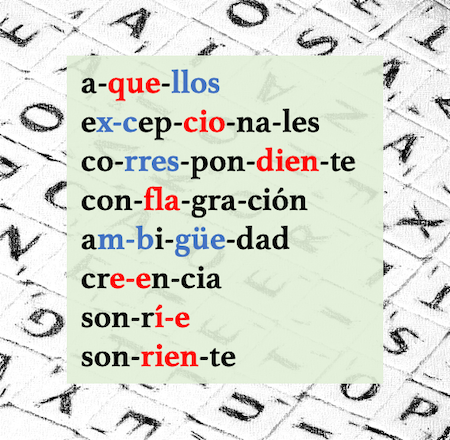|
Una sílaba es un grupo de sonidos pronunciado alrededor de una o más vocales en una sola bocanada de aire. Por ejemplo, Pa-na-má tiene tres sílabas; cla-ro tiene dos; bien tiene una.
Estas son las reglas básicas para dividir una palabra en sílabas:
|
A syllable is a group of sounds which is pronounced around one or more vowels in a single breath of air. For example, Pa-na-má has three syllables; cla-ro has two; bien has one.
Here are the basic rules for dividing a Spanish word into syllables:
|
| 1. Siempre que sea posible, cada sílaba termina en vocal (cada consonante se une a la vocal siguiente): |
1. Whenever possible, syllables end in a vowel (each consonant is attached to the following vowel): |
| ca-ri-ño ¦ o-ro ¦ re-loj ¦ le-jos ¦ ge-ne-ra-li-da-des ¦ na-tu-ra-le-za ¦ lu-gar ¦ lu-ga-res ¦ e-xa-men ¦ ca-paz ¦ ca-pa-ces ¦ a-mi-ga |
| 2. Las grafías dobles que representan un solo sonido, nunca se separan: ⟨ch⟩, ⟨ll⟩, ⟨rr⟩, ⟨qu⟩ (que, qui), ⟨gu⟩ (gue, gui) |
2. Never separate the following pairs of letters, because they represent only one sound: ⟨ch⟩, ⟨ll⟩, ⟨rr⟩, ⟨qu⟩ (que, qui), ⟨gu⟩ (gue, gui) |
| no-che ¦ ca-lles ¦ a-que-llos ¦ pe-rros ¦ gui-ta-rra ¦ pa-gue-mos ¦ re-qui-si-tos ¦ co-rre-la-ción |
| 3. Dos consonantes consecutivas generalmente se separan en sílabas diferentes: |
3. Two consecutive consonants will generally belong to separate syllables |
| ac-ción ¦ nun-ca ¦ cuan-do ¦ cor-tar ¦ am-bi-guo ¦ al-can-zar ¦ en-ri-que-cer ¦ per-la ¦ al-go ¦ es-la-bón ¦ es-ca-lar ¦ hin-char ¦ ad-he-rir |
| 4. ⟨r⟩ y ⟨l⟩ después de otras consonantes forman una unidad sonora y pertenecen a la misma sílaba (excepto después de ⟨n⟩ o ⟨s⟩). |
4. ⟨r⟩ and ;⟨l⟩ after other consonants form a sound unit and belong in the same syllable (except after ⟨s⟩ or ⟨n⟩). |
| ha-blar ¦ som-bri-lla ¦ con-tra-to ¦ ex-pli-car ¦ es-cla-vo ¦ a-dre-na-li-na ¦ con-fla-gra-ción ¦ A-tlán-ti-co ¦ si-glo ¦ com-prar |
| 5. Si hay tres consonantes consecutivas, solo la tercera va con la siguiente vocal (excepto en las combinaciones mencionadas en el #4) |
5. When there are three consecutive consonants, only the third one is attached to the following vowel (except in the combinations mentioned in #4 above) |
| cons-tan-te ¦ ins-ti-tu-to ¦ PERO: tras-plan-tar ¦ som-bri-lla ¦ in-glés |
| 6. Dos vocales abiertas (a, e, o) van en sílabas separadas, así como cualquier vocal duplicada: |
6. Two consecutive strong vowels (a, e, o), as well as any duplicate vowels, belong to separate syllables. |
| ma-es-tro ¦ te-a-tro ¦ co-o-pe-rar ¦ po-e-ta ¦ ca-os ¦ ta-re-a ¦ a-é-re-o ¦ lí-ne-a ¦ le-er ¦ chi-i-ta |
| 7. Dos vocales cerradas (i, u) o una vocal cerrada átona junto a una abierta, forman una sola sílaba: |
7. Two weak vowels (i, u) or an unstressed weak vowel next to a strong one, form one single syllable. |
| bue-no ¦ rui-do ¦ ai-re ¦ can-ción ¦ ciu-dad ¦ trau-ma ¦ a-gua ¦ pin-güi-no ¦ so-cial ¦ vien-to ¦ cuan-do ¦ Eu-ro-pa ¦ se-ries ¦ Pa-ra-guay |
| 8. Pero una vocal cerrada tónica y una abierta, van en sílabas separadas. |
8. But a stressed weak vowel and a strong one, belong to separate syllables |
| dí-as ¦ dú-o ¦ ma-íz ¦ ge-o-gra-fí-a ¦ o-í-do ¦ son-rí-en ¦ pa-ís ¦ tí-o ¦ ba-úl |


